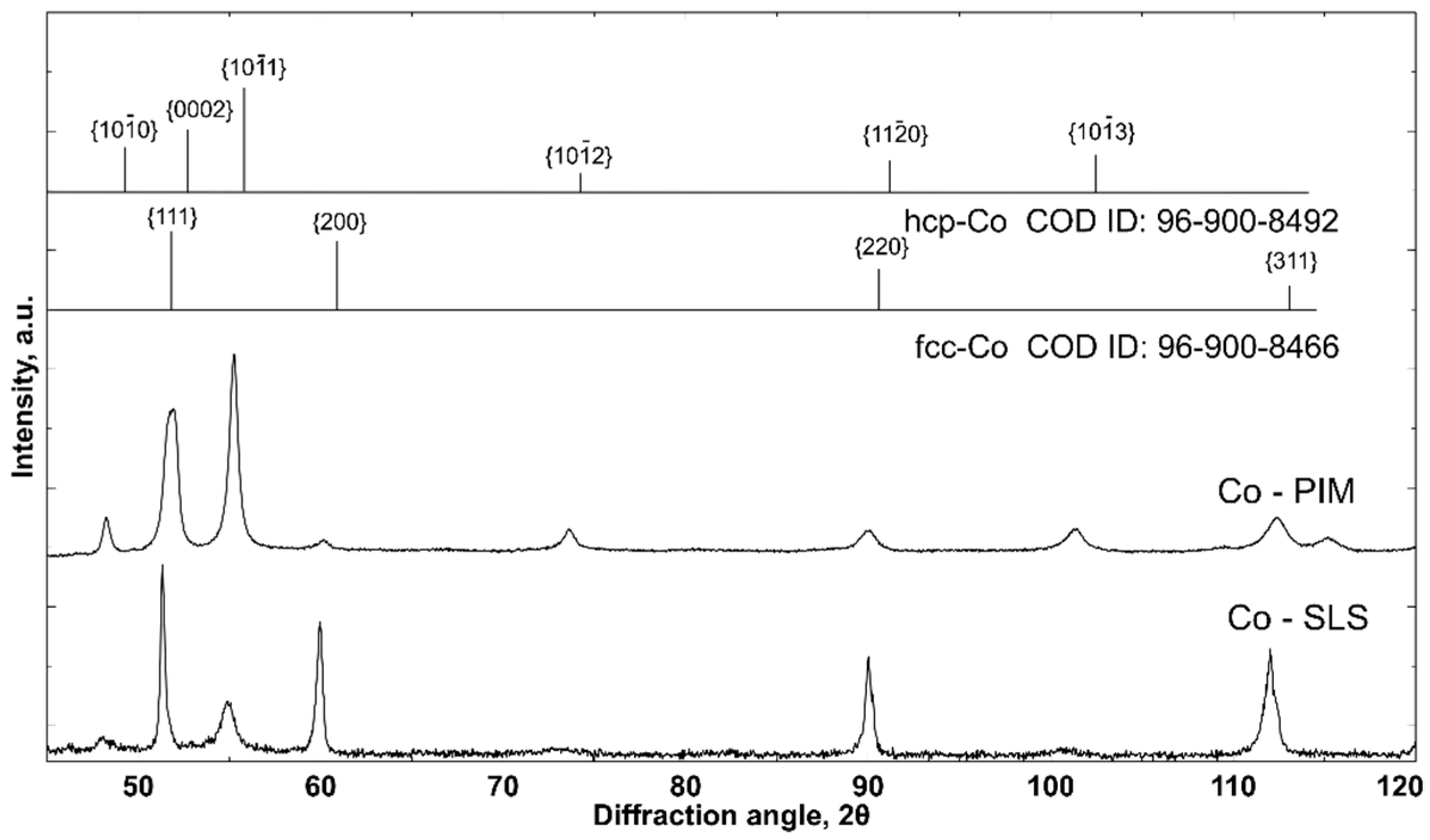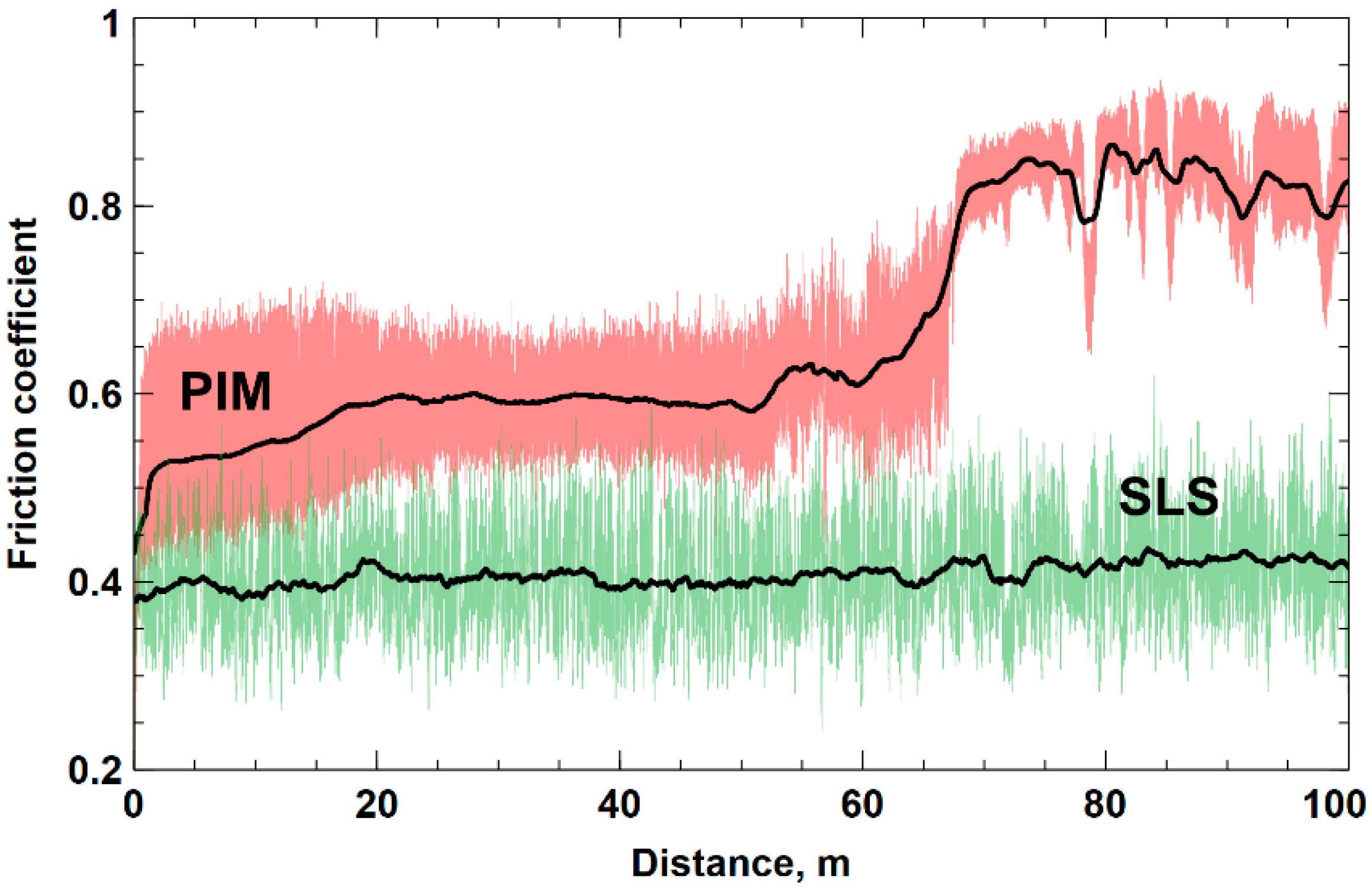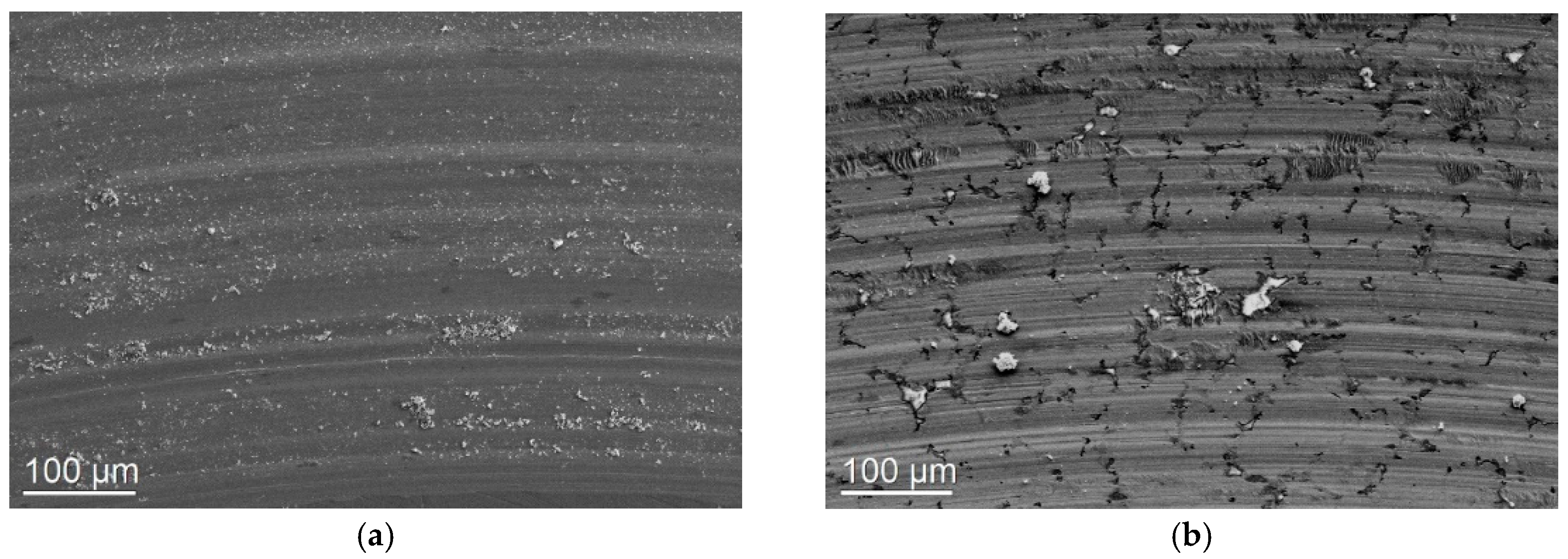Comparison of the Crystal Structure and Wear Resistance of Co-Based Alloys with Low Carbon Content Manufactured by Selective Laser Sintering and Powder Injection Molding
Abstract
1. Introduction
2. Materials and Methods
3. Results
3.1. Crystalline Structure and Microstructure of Co-SLS and Co-PIM
3.2. Wear Resistance of Co-SLS and Co-PIM
4. Discussion
5. Conclusions
Author Contributions
Funding
Conflicts of Interest
References
- Saldívar García, A.D.J.; Medrano, A.M.; Salinas Rodríguez, A. Formation of hcp martensite during the isothermal aging of an fcc Co-27Cr-5Mo-0.05C orthopedic implant alloy. Metall. Mater. Trans. A Phys. Metall. Mater. Sci. 1999, 30, 1177–1184. [Google Scholar] [CrossRef]
- Lopez, H.F. Alloy developments in biomedical co-base alloys for HIP implant applications. Mater. Sci. Forum 2013, 736, 133–146. [Google Scholar]
- Yamanaka, K.; Mori, M.; Kurosu, S.; Matsumoto, H.; Chiba, A. Ultrafine grain refinement of biomedical Co-29Cr-6Mo alloy during conventional hot-compression deformation. Metall. Mater. Trans. A Phys. Metall. Mater. Sci. 2009, 40, 1980–1994. [Google Scholar] [CrossRef]
- Talonen, J.; Hänninen, H. Formation of shear bands and strain-induced martensite during plastic deformation of metastable austenitic stainless steels. Acta Mater. 2007, 55, 6108–6118. [Google Scholar] [CrossRef]
- Wei, W.; Zhou, Y.; Liu, W.; Li, N.; Yan, J.; Li, H. Microstructural Characterization, Mechanical Properties, and Corrosion Resistance of Dental Co-Cr-Mo-W Alloys Manufactured by Selective Laser Melting. J. Mater. Eng. Perform. 2018, 27, 5312–5320. [Google Scholar] [CrossRef]
- Karaali, A.; Mirouh, K.; Hamamda, S.; Guiraldenq, P. Microstructural study of tungsten influence on Co-Cr alloys. Mater. Sci. Eng. A 2005, 390, 255–259. [Google Scholar] [CrossRef]
- Marchese, G.; Garmendia Colera, X.; Calignano, F.; Lorusso, M.; Biamino, S.; Minetola, P.; Manfredi, D. Characterization and Comparison of Inconel 625 Processed by Selective Laser Melting and Laser Metal Deposition. Adv. Eng. Mater. 2017, 19, 1600635. [Google Scholar] [CrossRef]
- Mindt, H.W.; Desmaison, O.; Megahed, M.; Peralta, A.; Neumann, J. Modeling of Powder Bed Manufacturing Defects. J. Mater. Eng. Perform. 2018, 27, 32–43. [Google Scholar] [CrossRef]
- Kruth, J.P.; Mercelis, P.; Van Vaerenbergh, J.; Froyen, L.; Rombouts, M. Binding mechanisms in selective laser sintering and selective laser melting. Rapid Prototyp. J. 2005, 11, 26–36. [Google Scholar] [CrossRef]
- Ziębowicz, A.; Woźniak, A.; Ziębowicz, B. The influence of technology on the physicochemical and electrochemical properties of the prosthetic materials. In Proceedings of the Advances in Intelligent Systems and Computing, Katowice, Poland, 18–20 October 2018; Springer: Cham, Switzerland; Volume 623, pp. 349–357. [Google Scholar]
- Harris, I.D. A Transformational Advanced Manufacturing Technology. Adv. Mater. Processes 2012, 25. [Google Scholar]
- German, R.M. Wear applications offer further growth for PIM. Met. Powder Rep. 1999, 54, 24–28. [Google Scholar] [CrossRef]
- Wahi, A.; Muhamad, N.; Sulong, A.B.; Ahmad, R.N. Effect of Sintering Temperature on Density, Hardness and Strength of MIM Co30Cr6Mo Biomedical Alloy. J. Jpn. Soc. Powder Powder Metall. 2016, 63, 434–437. [Google Scholar] [CrossRef]
- Matula, G.; Tomiczek, B.; Król, M.; Szatkowska, A.; Sotomayor, M.E. Application of thermal analysis in the selection of polymer components used as a binder for metal injection moulding of Co–Cr–Mo alloy powder. J. Therm. Anal. Calorim. 2018, 134, 391–399. [Google Scholar] [CrossRef]
- ASTM G99—95a Test Method for Wear Testing with a Pin-On-Disk Apparatus; ASTM International: West Conshohocken, PA, USA, 2000.
- ISO/TS 14569-2:2001. Dental Materials—Guidance on Testing of Wear—Part 2: Wear by Two—And/or Three Body Contact; ISO: Geneva, Switzerland, 2001. [Google Scholar]
- Wyckoff, R.W.G. Cubic Closest Packed, ccp, Structure. In Crystal Structures, 2nd ed.; Interscience Publishers: New York, NY, USA, 1963; pp. 7–83. [Google Scholar]
- Zhou, Y.; Wei, W.; Yan, J.; Liu, W.; Li, N.; Li, H.; Xu, S. Microstructures and metal-ceramic bond properties of Co-Cr biomedical alloys fabricated by selective laser melting and casting. Mater. Sci. Eng. A 2019, 759, 594–602. [Google Scholar] [CrossRef]
- Weissensteiner, I.; Petersmann, M.; Antretter, T.; Clemens, H.; Weißensteiner, I.; Erdely, P.; Stark, A.; Maier-Kiener, V. Deformation-induced phase transformation in a Co-Cr-W-Mo alloy studied by high-energy X-ray diffraction during in-situ compression tests. Acta Mater. 2018, 164, 272–282. [Google Scholar] [CrossRef]
- Frommeyer, G.; Métallurgie, O.G.-R. High strength TRIP/TWIP and superplastic steels: Development, properties, application. Rev. Métallurgie 1998, 95, 1299–1310. [Google Scholar] [CrossRef]
- Zaefferer, S.; Ohlert, J.; Bleck, W. A study of microstructure, transformation mechanisms and correlation between microstructure and mechanical properties of a low alloyed TRIP steel. Acta Mater. 2004, 52, 2765–2778. [Google Scholar] [CrossRef]
- Grässel, O.; Krüger, L.; Frommeyer, G.; Meyer, L.W. High strength Fe–Mn–(Al, Si) TRIP/TWIP steels development—Properties—Application. Int. J. Plast. 2000, 16, 1391–1409. [Google Scholar] [CrossRef]
- Mengucci, P.; Barucca, G.; Gatto, A.; Bassoli, E.; Denti, L.; Fiori, F.; Czyrska-Filemonowicz, A. Effects of thermal treatments on microstructure and mechanical properties of a Co–Cr–Mo–W biomedical alloy produced by laser sintering. J. Mech. Behav. Biomed. Mater. 2016, 60, 106–117. [Google Scholar] [CrossRef]
- Santecchia, E.; Gatto, A.; Bassoli, E.; Denti, L.; Rutkowski, B.; Mengucci, P.; Barucca, G. Precipitates formation and evolution in a Co-based alloy produced by powder bed fusion. J. Alloys Compd. 2019, 797, 652–658. [Google Scholar] [CrossRef]
- Yamanaka, K.; Mori, M.; Koizumi, Y.; Chiba, A. Local strain evolution due to athermal γ → ε martensitic transformation in biomedical CoCrMo alloys. J. Mech. Behav. Biomed. Mater. 2014, 32, 52–61. [Google Scholar] [CrossRef] [PubMed]
- Wang, H.; Luan, D.; Zhang, L.Y. Microstructure and wear resistance of laser melted W/W2Ni3Si metal silicides matrix in situ composites. Scr. Mater. 2003, 48, 1179–1184. [Google Scholar] [CrossRef]
- Liu, Y.; Wang, H.W. Toughening and dry sliding wear resistance of Co3Mo2Si alloys. Wear 2013, 297, 952–957. [Google Scholar] [CrossRef]
- Liu, Y.; Wang, H.M. Microstructure and wear property of laser-clad Co3Mo2Si/Coss wear resistant coatings. Surf. Coat. Technol. 2010, 205, 377–382. [Google Scholar] [CrossRef]
- Dickins, G.J.; Douglas, A.M.B.; Taylor, W.H. The crystal structure of the Co–Cr σ phase. Acta Crystallogr. 1956, 9, 297–303. [Google Scholar] [CrossRef]
- Varano, R.; Bobyn, J.D.; Medley, J.B.; Yue, S. The effect of microstructure on the wear of cobalt-based alloys used in metal-on-metal hip implants. Proc. Inst. Mech. Eng. Part H J. Eng. Med. 2006, 220, 145–159. [Google Scholar] [CrossRef]
- Chiba, A.; Kumagai, K.; Nomura, N.; Miyakawa, S. Pin-on-disk wear behavior in a like-on-like configuration in a biological environment of high carbon cast and low carbon forged Co-29Cr-6Mo alloys. Acta Mater. 2007, 55, 1309–1318. [Google Scholar] [CrossRef]
- Saldívar-García, A.J.; López, H.F. Microstructural effects on the wear resistance of wrought and as-cast Co-Cr-Mo-C implant alloys. J. Biomed. Mater. Res. Part A 2005, 74, 269–274. [Google Scholar] [CrossRef]
- Bedolla-Gil, Y.; Hernandez-Rodriguez, M.A.L. Tribological behavior of a heat-treated cobalt-based alloy. J. Mater. Eng. Perform. 2013, 22, 541–547. [Google Scholar] [CrossRef]
- Yan, Y.; Neville, A.; Dowson, D. Tribo-corrosion properties of cobalt-based medical implant alloys in simulated biological environments. Wear 2007, 263, 1105–1111. [Google Scholar] [CrossRef]
- Long, W.T. The clinical performance of metal-on-metal as an articulation surface in total hip replacement. Iowa Orthop. J. 2005, 25, 10–16. [Google Scholar] [PubMed]
- Cawley, J.; Metcalf, J.E.P.; Jones, A.H.; Band, T.J.; Skupien, D.S. A tribological study of cobalt chromium molybdenum alloys used in metal-on-metal resurfacing hip arthroplasty. Wear 2003, 255, 999–1006. [Google Scholar] [CrossRef]
- Tipper, J.L.; Firkins, P.J.; Ingham, E.; Fisher, J.; Stone, M.H.; Farrar, R. Quantitative analysis of the wear and wear debris from low and high carbon content cobalt chrome alloys used in metal on metal total hip replacements. J. Mater. Sci. Mater. Med. 1999, 10, 353–362. [Google Scholar] [CrossRef] [PubMed]
- Dowson, D.; Hardaker, C.; Flett, M.; Isaac, G.H. A hip joint simulator study of the performance of metal-on-metal joints: Part I: The role of materials. J. Arthroplast. 2004, 19, 118–123. [Google Scholar] [CrossRef]
- Scholes, S.C.; Unsworth, A. Pin-on-plate studies on the effect of rotation on the wear of metal-on-metal samples. J. Mater. Sci. Mater. Med. 2001, 12, 299–303. [Google Scholar] [CrossRef]
- Zhang, M.; Yang, Y.; Song, C.; Bai, Y.; Xiao, Z. An investigation into the aging behavior of CoCrMo alloys fabricated by selective laser melting. J. Alloys Compd. 2018, 750, 878–886. [Google Scholar] [CrossRef]
- Hassani, F.Z.; Ketabchi, M.; Bruschi, S.; Ghiotti, A. Effects of carbide precipitation on the microstructural and tribological properties of Co–Cr–Mo–C medical implants after thermal treatment. J. Mater. Sci. 2016, 51, 4495–4508. [Google Scholar] [CrossRef]












| Co | Cr | Mo | W | Si | Fe | Mn | C | |
|---|---|---|---|---|---|---|---|---|
| SLS | 63.8 | 24.7 | 5.1 | 5.4 | 1.0 | <0.5 | <0.1 | <0.05 |
| PIM | 64.9 | 27.0 | 5.3 | <0.2 | <1.0 | <0.75 | <1 | <0.05 |
| Element | Co | Cr | Mo | Si | W |
|---|---|---|---|---|---|
| Matrix | 65.9 ± 0.6 | 24.1 ± 0.4 | 4.6 ± 0.3 | 1.2 ± 0.1 | 4.2 ± 0.2 |
| Elongated precipitate | 41.1 ± 1.0 | 11.9 ± 0.5 | 21.5 ± 1.3 | 3.9 ± 0.6 | 21.6 ± 1.1 |
| Spherical precipitate | 62.2 ± 0.7 | 24.0 ± 0.4 | 4.1 ± 0.4 | 6.8 ± 0.3 | 2.9 ± 0.2 |
| Element | Co | Cr | Mo | C | Si |
|---|---|---|---|---|---|
| A | 2.0 ± 0.1 | 87.4 ± 1.0 | 10.6 ± 0.4 | n. d. | 0 |
| B | 40.4 ± 0.5 | 50.1 ± 0.5 | 7.9 ± 0.3 | n. d. | 1.6 ± 0.1 |
| C | 68.2 ± 0.5 | 26.6 ± 0.3 | 5.2 ± 0.2 | n. d. | 0 |
© 2020 by the authors. Licensee MDPI, Basel, Switzerland. This article is an open access article distributed under the terms and conditions of the Creative Commons Attribution (CC BY) license (http://creativecommons.org/licenses/by/4.0/).
Share and Cite
Ziębowicz, A.; Matus, K.; Pakieła, W.; Matula, G.; Pawlyta, M. Comparison of the Crystal Structure and Wear Resistance of Co-Based Alloys with Low Carbon Content Manufactured by Selective Laser Sintering and Powder Injection Molding. Crystals 2020, 10, 197. https://doi.org/10.3390/cryst10030197
Ziębowicz A, Matus K, Pakieła W, Matula G, Pawlyta M. Comparison of the Crystal Structure and Wear Resistance of Co-Based Alloys with Low Carbon Content Manufactured by Selective Laser Sintering and Powder Injection Molding. Crystals. 2020; 10(3):197. https://doi.org/10.3390/cryst10030197
Chicago/Turabian StyleZiębowicz, Anna, Krzysztof Matus, Wojciech Pakieła, Grzegorz Matula, and Miroslawa Pawlyta. 2020. "Comparison of the Crystal Structure and Wear Resistance of Co-Based Alloys with Low Carbon Content Manufactured by Selective Laser Sintering and Powder Injection Molding" Crystals 10, no. 3: 197. https://doi.org/10.3390/cryst10030197
APA StyleZiębowicz, A., Matus, K., Pakieła, W., Matula, G., & Pawlyta, M. (2020). Comparison of the Crystal Structure and Wear Resistance of Co-Based Alloys with Low Carbon Content Manufactured by Selective Laser Sintering and Powder Injection Molding. Crystals, 10(3), 197. https://doi.org/10.3390/cryst10030197







